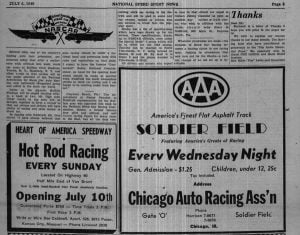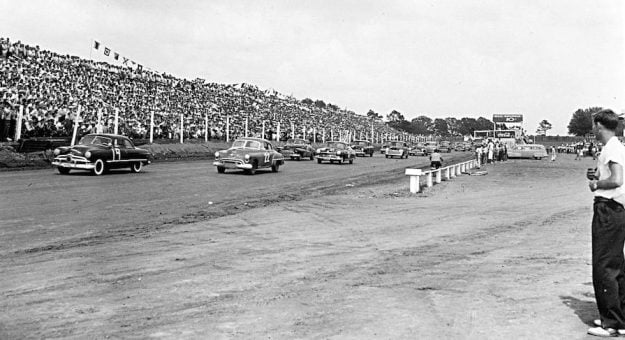Editor’s Note: NASCAR is celebrating its 75th anniversary in 2023. SPEED SPORT was founded in 1934 and was already on its way to becoming America’s Motorsports Authority when NASCAR was formed. As a result, we will bring you a 75-part series on the history of NASCAR as told in the pages of National Speed Sport News and SPEED SPORT Magazine.
Two days after NASCAR’s first banquet at which championship points money was awarded and the accomplishments of the first year were lauded, the 1949 season roared out of the pits and onto the Beach Course at Daytona Beach, Fla.
The 200-mile event on Jan. 16 was run on an expanded 4.3-mile beach-road course in front of 12,000 fans.
Seventy-six entrants started the ninth annual show, including defending champion
Red Byron, Fonty, Tim and Bob Flock and Curtis Turner. However, it was Marshall Teague who paced the field. Teague’s strategy was simple: if your fuel tank is big enough, you never have to pit and, therefore, you have a better chance to grab the checkers. Teague’s oversized 36-gallon tank gave him enough gas to drive his 1939 Tudor sedan into victory lane.
NASCAR Accelerates Toward Second Season
While the drivers began the year in a familiar place, NASCAR President Bill France was still adjusting to his new office in Daytona Beach. Yet, the driven stock car association founder accelerated the changes that began in 1948 through NASCAR’s second season.
New race sites were added throughout the year, including Broward Speedway, a two-mile paved oval in Fort Lauderdale, which hosted the second event of the year, a 100-miler. A NASCAR-sanctioned race opened the New Atlanta Speedway in March drew a crowd of 8,700.

The new half-mile Harris Super Speedway in Concord, N.C., was christened in June by a NASCAR double feature.
NASCAR also visited Columbia, S.C., for the first time and ventured north to Hamburg, N.Y., and Heidelberg, Pa.
Further expansion into the northeastern United States came in July when a major race promoter, Edward Otto, signed an agreement to make all of the races at his tracks NASCAR- sanctioned.
While the modified division continued to be the key NASCAR class, the NASCAR Cup Series made its debut with eight races for what was known as the Strictly Stock class. Jim Roper won the Strictly Stock opener at Charlotte (N.C.) Speedway on June 19, 1949.
The following year the class was rebranded — Grand National — and became NASCAR’s premier division.
Byron went on to became the Strictly Stock champion over Lee Petty and Bob Flock, while Fonty Flock captured the modified title.
The July 6 issue of NSSN commented on the implications of the move: “The invasion of stock car racing becomes a leading factor in our racing sport. Judging by attendance that now turn out for the stocks — a radical change of the old set-up is inevitable.”
Indeed, NASCAR was driving on the point of racing’s transformation.
A Radical Change & A Scoring System
Behind the change in stock car racing was France’s vision of equally equipped cars and a firm scoring system.
While a wide variety of vehicles could qualify for NASCAR sportsman events, such as the English-made Jaguar and MGs that ran at Broward Speedway, along with car models dating back to 1936, stock entrants, by rule, consisted of “no-souped up” 1946 to 1949 model cars. The idea was to make stock car racing attractive to more fans by competing with the cars average drivers owned.
Equally important, according to the June 29 issue of NSSN, was the guarantee that “under NASCAR sanction there will be none of the scoring mix ups which have marked long races at many tracks.”
With the kinds of cars eligible to race and the number of points gained for leading laps and for victories cast in stone, both fans and drivers knew the uncertainty and cheating of years past would be much reduced.
Along with the coveted points title, Byron earned the honor of being named NASCAR’S outstanding stock car driver in a poll of his peers. Joe Wolf upset Red Vogt for the outstanding mechanic title in the poll and Sara Christian was named the best female driver of the three who competed in NASCAR in 1949.
